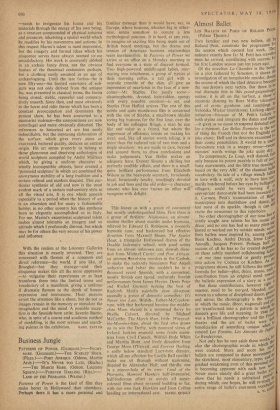Almost Ballet
LES BALLETS DE PARIS DE ROLAND PETIT' (Palace Theatre.) Two familiar and two new ballets,e all Of' Roland Petit, constitute the programme the season which opened last week. pi° indicate exactly how far M. Petit has travelled since he arrived, scintillating with success, fel his first London season just ten years ago. Of the novelties La Cliambre is the baler; on a plot fathered by Simenon, it shows tile investigation of an inexplicable murder, &rid; the course of which the chief detective becorflei the murderess's next victim. But there is lin real dramatic bite in this grand-guignolese notion; it is all on the surface, a shosv nf eccentric dancing by Buzz Miller (detective) and of erotic gyrations and tumbling bY Veronika Mlakar (murderess). Lacking cher°. terisation—because of M. Petit's failure both stylise and ,integrate the dance and Min! —it gives us no cause to suspend disbelief for a moment. Les Belles Damnees is the On of thing the French (but not the English) eati joke about; Hell and its denizens examined fee their comic possibilities. It would be a useitil five-minute trick in a snappy revue—two minutes' worth wrings the joke quite drY.
To compensate, Le Loup, well danced, fails
only because its potent parable is full of over fussy movements, and the little true dancing is based on the very ABC of the classical ballet vocabulary. Its tale of a village wench felinig in love with a wolf, only to have him sins, madly butchered before her eyes by belligeferl' villagers, could be very moving il f flf/ appropriate dance-style had been invented (41( it. Carmen, Petit's transmutation of E bi35 masterpiece into dumbshow and dance, . lost most of its sparkle, though it cafl excite the newcomer to this repertoire. No other choreographer of our time hos avidly sought new talents for his music all: decor, and no one has had so many plot!
;
gested or worked out by outside minds; e °ler
a
Petit ballets were inspired .by, among others' Boris Kochno, Andre Derain, Irene Lid° Anouilh, Jacques Prevent. Perhaps half thr success of all he has so far created dellifif dej on these subtly matched collaborating 0 1 —at one time supervised or gently Prcdde' into action by Cocteau or Koehn°. Ai programme shows, he still follows the essi formula for ballet—plot, decor, music, el 0113 ord'
contribution from an original mind to l i
the balletic expression of a story or a eriet
But these contributions, however rigb l
essence, need to be merged, blended, inter'. woven in a scheme of disciplined dance, ggstur' and mime; the choreography is the a.e, in whieh the music, decor, stagecraft am' r he are transformed into a pattern to whic_h petd dancers give life and meaning. In 1946 A was a brilliant choreographer and the IIbodi theatre and the art of ballet were 1/0 beneficiaries of something unique whe
„igt, created Les Forains, Les Amours de INF Le Rendezvous.di) t Not only has he cast aside these works,thei also the choreographic mode in which
tier
were created. More and more his - 0
ballets are composed in dance moverneni till the sketchiest, most elementary, type; an,istyli gradual weakening even of this personal t is becoming apparent with each new Never more clearly did a great ballet .1'1 toe show that he needs a sabbatical Perjobt during which, one hopes, he will re-saw" s entire range of ballet's enormous vocabL cof°
A.


































 Previous page
Previous page